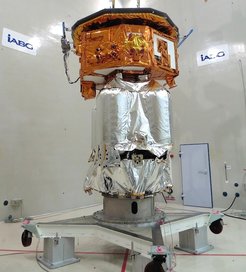LISA Pathfinder on the way to launch
The satellite is completed
LISA Pathfinder (LPF), the test mission to demonstrate new technologies necessary for the planned gravitational wave observatory eLISA, will be shipped to the spaceport in Kourou on September 3rd, 2015, in preparation for launch. “We have developed completely new technologies to capture the sound of the universe in the future. Now we are eagerly awaiting launch and the first data”, says Prof. Karsten Danzmann, director at the AEI and professor at the Leibniz Universität Hannover.

LISA Pathfinder will test novel technologies in space whose function and performance cannot be tested on the ground at all or only in a limited fashion. LPF will pave the way for the gravitational wave observatory eLISA. Other space missions are already benefiting from the new technologies. One example is the laser ranging interferometer used in the earth observation mission Grace Follow-On, scheduled for launch in 2017.
The Max Planck Institute for Gravitational Physics (Albert Einstein Institute/AEI) in Hannover played a leading role in the development and construction of the optical scientific instrumentation for LISA Pathfinder. Joint scientific leadership is held by Prof. Karsten Danzmann and Prof. Stefano Vitale from the University of Trento, Italy.
The highly sensitive scientific payload was integrated into the satellite in the last weeks, followed by last function and environment tests. The propulsion module and the launch vehicle adapter were also installed. Now shipment to ESA spaceport Kourou/French Guayana is imminent. From there, the mission will lift off in late autumn on a Vega launcher.
The LPF scientists are now preparing intensively for LPF mission operations. Once LPF has reached its destination, they will extensively test the highly precise technologies on board for a period of several months while maintaining a constant dialogue with the satellite.
LISA Pathfinder is an ESA mission, with the European space industry under the overall integration responsibility of Airbus DS and research institutions from France, Germany, Italy, the Netherlands, Spain, Switzerland and Great Britain as well as NASA participating.
LISA Pathfinder is funded through the German Aerospace Center (Deutsches Zentrum für Luft- und Raumfahrt; DLR) by the Federal Ministry for Economic Affairs and Energy based on a resolution of the German Bundestag.
Background information after the page break
The highly sensitive measurement system of LISA Pathfinder
Two identical cube-shaped test masses weighing about two kilograms each will be free-floating in their own vacuum canisters for the duration of the mission. They will be almost free of all internal and external disturbances and will thus allow the demonstration of the precise measurement of free-falling masses in space. A special gold-platinum alloy has been used for the masses to eliminate any influence from magnetic forces. Using ultraviolet radiation, a contact-free discharge system prevents electrostatic charge build-up on the test masses. The caging and grabbing mechanism – responsible for protecting the test masses from intense vibrations during launch, releasing them in a highly controlled setting, and capturing them as necessary – is a particular challenge in this context. A laser interferometer will measure the position and orientation of the two test masses relative to the spacecraft and to each other with a precision of approximately 10 picometers (one hundred millionth of a millimetre). In addition, there are less precise capacitive inertial sensors that also help determine their positions. The positional data is used by a Drag-Free Attitude Control System (DFACS) to control the spacecraft and ensure it always remains centered on one test mass. The actual position of the satellite is controlled through cold gas micronewton thrusters, which have the capability of delivering propulsion in extremely fine and uniform amounts. The thrust generated is in the micronewton range – this equates to the weight of a grain of sand on Earth.
Paving the way for new astronomy
LISA Pathfinder paves the way for eLISA, a large space observatory for the direct observation of one of the most elusive astronomical phenomena – gravitational waves. These tiny distortions of space-time were predicted by Albert Einstein and their observation requires an extremely sensitive and highly precise measurement technology. Space observatories like eLISA will measure gravitational waves in the millihertz range. They will complement ground-based detectors such as GEO600, aLIGO, and Virgo, which observe at higher frequencies in the audio range. Gravitational wave observatories will probe unknown domains – the “dark side of the universe” – in concert with other astronomical methods. One example is the formation, growth and merger of massive black holes. It will also be possible to further test Einstein’s Theory of General Relativity and search for unknown physics.












